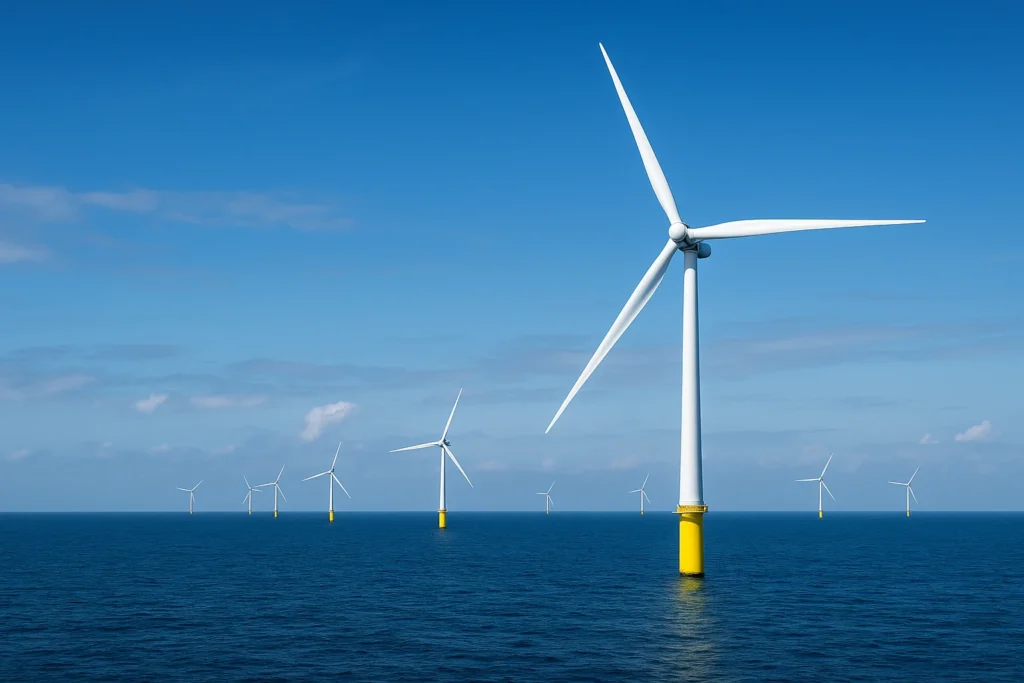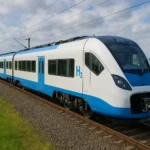The North Sea does not give its power freely. For millennia, it has been a realm of myth and hardship, a tempestuous expanse where the weather is a primal force and the waters conceal ancient secrets. To those who have worked its waves—from Viking explorers to North Sea oil riggers—it has always demanded respect, offering its bounty only at a price. But today, a new chapter is being written upon this storied seascape. We are no longer merely extracting from the North Sea; we are collaborating with it, engaging in a grand project of coexistence. At the heart of this new relationship stands a testament to human ambition: the Dogger Bank Wind Farm, now officially the largest offshore wind project on Earth. This is not just an engineering feat; it is a story of a lost world rediscovered, of technological wonder, and of a defiant, hopeful step toward a sustainable future for our planet.
Prologue: The Echoes of Doggerland – A Sunken World Reimagined
To truly grasp the significance of the Dogger Bank Wind Farm, one must first journey back through time, to an era when the geography of Europe was utterly alien. During the last glacial period, much of the Earth’s water was locked in vast ice sheets, causing sea levels to drop hundreds of feet. What is now the stormy, grey North Sea was, for a period of over 6,000 years, a vast, low-lying expanse of land known as Doggerland.
This was no barren tundra. Pollen samples from deep-sea cores reveal a landscape of rolling hills, dense forests, sprawling wetlands, and meandering rivers. It was a rich ecosystem teeming with life: giant aurochs, red deer, wild boar, and even mammoths roamed its plains. It was also home to Mesolithic humans—small, nomadic bands of hunter-gatherers who left behind flint tools, bone harpoons, and the occasional poignant artifact, like a fossilized human footprint found preserved in the silt.
Then, around 6,500 BC, the climate shifted. The glaciers retreated, and the seas began to rise. The water poured in from the north and south, slowly, inexorably swallowing Doggerland. The forests drowned, the hills became islands, and the islands vanished. The people were forced to retreat, their homeland disappearing forever beneath the waves, leaving behind only a vast, shallow sandbank—the largest in the North Sea—as its sole monument.
This geological history is the silent, foundational partner in the modern project. The Dogger Bank’s unique shallowness—averaging just 15 to 36 meters deep across an area larger than Wales—made it the singularly perfect foundation for a fixed-bottom wind farm of unprecedented scale. The very wind that once howled across the plains of Doggerland now spins the turbines that stand as its legacy. The past is literally powering the present.
The Immense Scale: Conceptualizing the Unimaginable
The term “world’s largest” is used often, but for Dogger Bank, it demands context. This is not a single project so much as a coordinated trio of megaprojects, each of which would be a record-setter on its own. Developed in three phases—Dogger Bank A, B, and C—the farm is a staggering colossus of modern infrastructure.
By the Numbers:
- Total Capacity: 3.6 Gigawatts (GW). One gigawatt can power approximately 750,000 average American homes. At full capacity, Dogger Bank’s 3.6 GW can power the equivalent of 6 million UK homes.
- Turbine Count: 277 GE Haliade-X turbines.
- Maritime Footprint: The development zone spans approximately 8,660 square kilometers, an area larger than the entire county of Cornwall.
- Cable Length: Over 6,500 kilometers of high-voltage DC and AC subsea cables will be installed, enough to stretch from London to Chicago.
The project is a masterclass in international collaboration and investment. It is a joint venture between UK-based SSE Renewables, who lead the construction; Norwegian energy giant Equinor, who will lead the long-term operations; and Vårgrønn, a green energy company. The financial commitment runs into the billions, representing one of the largest private investments in UK infrastructure history. This consortium represents a strategic pivot for the energy industry, a move from fossil fuels to a future built on renewables.
The Titans: An Anatomy of the Haliade-X Turbine
If Dogger Bank is the body, the turbines are its beating heart. The GE Haliade-X is not an incremental upgrade; it is a paradigm shift in wind technology, a machine of such scale and efficiency that it redefines the limits of the industry. To stand before one is to witness a marvel of modern engineering.
A Dimensions Breakdown:
- Tip Height: 260 meters (853 feet). This is taller than the Gherkin skyscraper in London and only 30 meters shorter than the Shard, Western Europe’s tallest building. If placed at the base of the Great Pyramid of Giza, its blade tip would soar high above the apex.
- Rotor Diameter: 220 meters (722 feet). The sweep area of the rotor is an astonishing 38,000 square meters—larger than the footprint of the Roman Colosseum.
- The Blades: Each of the three blades is 107 meters (351 feet) long. Manufactured by LM Wind Power, they are crafted from advanced composite materials using precision molds. Their aerodynamic design is the product of countless computational fluid dynamics simulations, optimized to capture the maximum energy from the wind with minimal resistance. Transporting these blades is a logistical ballet, requiring special convoys and route planning to navigate from factory to port.
- The Nacelle: This is the “brain” of the turbine, a box the size of a large suburban house that sits atop the tower. It contains the generator, the gearbox, and the control systems. Each nacelle weighs hundreds of tonnes and houses technology that allows the turbine to automatically yaw into the wind and pitch its blades to optimize output and protect itself in storm conditions.
- Power Output: Each revolution of the colossal rotor can generate enough electricity to power a UK home for over two days. At its rated capacity of 14.7 MW, a single Haliade-X turbine can generate more power than the entire first offshore wind farm ever built (Vindeby in Denmark, 1991).
The process of installing these behemoths is a feat of maritime engineering. The components are manufactured across Europe and the UK, then shipped to specially equipped ports like Able Seaton Port in Hartlepool, which has been transformed into a dedicated logistics hub. From there, the world’s largest jack-up vessels, like the Voltaire, sail out to the site. These ships are essentially floating cranes with legs that can be lowered to the seabed to create a stable platform in the deep water. In a carefully choreographed operation, crews work 24/7 to lift the massive tower sections, the nacelle, and the three blades into place, bolting them together with millimeter precision amidst the challenging and unpredictable North Sea weather.
The Invisible Highway: The HVDC Transmission Revolution
Generating immense power 130 kilometers offshore is one challenge; delivering it efficiently to the living rooms and factories that need it is another. This is where one of the project’s most significant technological innovations lies: a High-Voltage Direct Current (HVDC) transmission system.
Most of the world’s electrical grids operate on Alternating Current (AC), which is excellent for shorter distances. However, over long distances, AC power suffers from significant electrical losses—energy effectively bleeds away as heat. For a project as far offshore as Dogger Bank, using traditional AC cables would mean losing a substantial portion of the electricity generated before it even reached the coast.
The HVDC system acts as an energy superhighway, minimizing these losses. Here’s how it works:
- Offshore Conversion: At the wind farm, the AC power generated by the turbines is gathered together at three massive offshore converter platforms. These are immense offshore electrical substations, each the size of a football field and weighing thousands of tonnes. Inside, sophisticated technology converts the AC power into High-Voltage DC power.
- The Undersea Journey: This DC electricity is then sent racing through specially designed subsea cables, buried in the seabed to protect them from fishing gear and ship anchors. The cables for Dogger Bank are among the longest and highest-capacity ever produced.
- Onshore Conversion: The cables make landfall on the dramatic coastline of East Riding, Yorkshire. Here, at land-based converter stations, the DC power is transformed back into AC power that is compatible with the UK’s national grid.
This use of HVDC technology for such a large-scale renewable project sets a crucial precedent. It solves the fundamental problem of connecting remote, world-class renewable resources to population centers, paving the way for even more ambitious projects in the future.
The Human Engine: Jobs, Communities, and a Just Transition
A project of Dogger Bank’s magnitude is far more than steel and concrete; it is a powerful engine of human endeavor and economic revitalization. It represents the tangible reality of the “green jobs revolution” that is so often discussed.
Building a Workforce:
The construction phase has been a massive employer. It has supported up to 3,000 jobs in the UK during peak construction periods. These are not just temporary roles but skilled careers spanning:
- Marine Engineers and Crews: Operating the complex fleet of jack-up vessels, cable-laying ships, and support boats.
- Electrical Engineers: Designing and installing the complex HVDC systems.
- Metallurgists and Welders: Working on the massive foundations and structures.
- Project Managers and Logistics Coordinators: Orchestrating the immensely complex supply chain from factories across Europe to a precise point in the North Sea.
A Long-Term Legacy in the North East:
The most profound local impact is in the long-term operations and maintenance (O&M). The project has chosen the Port of Tyne in South Shields as its central O&M hub. This decision has transformed the port and the surrounding community.
- A brand-new, state-of-the-art O&M building houses a dedicated team of over 400 highly skilled technicians, engineers, and support staff.
- A fleet of specially designed, “walk-to-work” CTV (Crew Transfer Vessels) and larger SOV (Service Operation Vessels) are based here. These are not simple boats; they are floating hotels and workshops equipped with dynamic positioning systems, motion-compensated gangways, and helipads, allowing crews to safely access and service the turbines year-round, even in rough seas.
- These are long-term, local careers that will last for the project’s entire 35-year lifespan, offering stable employment and reinvigorating a region with a proud industrial and maritime heritage.
Energy Security in a Volatile World:
Beyond local jobs, Dogger Bank is a cornerstone of UK energy security. In an era of volatile global gas prices and geopolitical instability, the ability to generate power from a domestic, inexhaustible resource is strategically invaluable. It reduces the nation’s reliance on imported fossil fuels, insulating the economy and consumers from external price shocks and contributing to a more stable, sovereign energy supply.
The Environmental Calculus: Carbon, Climate, and Coexistence
The primary impetus for the global renewable energy transition is the urgent, existential threat of climate change. The burning of fossil fuels for energy is the largest contributor to greenhouse gas emissions, which are overheating the planet. Dogger Bank’s environmental contribution is its most critical output.
The Carbon Math:
- The farm will displace the need to burn natural gas in traditional power stations.
- It is projected to offset approximately 10 million tonnes of carbon dioxide (CO₂) emissions annually once fully operational.
- To contextualize this staggering figure:
- It is equivalent to removing 2.2 million internal combustion engine cars from the roads every year.
- It represents the annual carbon sequestration power of a forest covering approximately 1.5 million acres (nearly twice the size of Rhode Island).
This reduction is not a vague future promise; it is a quantifiable, ongoing action that directly supports the UK’s legally binding commitment to achieve net-zero carbon emissions by 2050. Dogger Bank is a powerful rebuttal to the idea that climate goals are unachievable; it is proof that large-scale, tangible change is already underway.
Marine Coexistence:
A project of this scale in a sensitive marine environment naturally raises questions about its ecological impact. The development of Dogger Bank was preceded by years of extensive environmental impact assessments. Every aspect was designed to minimize disruption:
- Seabed Surveys: Detailed mapping ensured cable routes and turbine placements avoided sensitive habitats.
- Noise Mitigation: During construction, “bubble curtains” were used to dampen the sound of pile driving, protecting marine mammals’ sensitive hearing.
- Artificial Reef Effect: The turbine foundations, over time, can act as artificial reefs, attracting mollusks, crustaceans, and small fish, which in turn can attract larger species, potentially increasing local biodiversity.
- Fishery Liaison: Constant communication with fishing communities ensures minimal conflict, and the designated areas between turbines can remain accessible to certain types of fishing.
The project exemplifies the concept of “responsible development,” acknowledging that the path to a green future must be tread carefully, with respect for the non-human world.
A Global Beacon: The Dogger Bank Blueprint
The resonance of Dogger Bank extends far beyond the territorial waters of the United Kingdom. It has instantly become a global benchmark, a proof-of-concept on a grand scale that is being closely studied by governments, energy firms, and investors on every continent with a coastline.
De-risking the Future:
By demonstrating that a project of this scale can be financed, built, and connected to the grid, Dogger Bank has effectively de-risked the entire sector of gigawatt-scale offshore wind. It provides a reproducible blueprint for planning, procurement, and execution, giving confidence to banks and investors to fund similar ventures elsewhere.
A Template for the World:
Nations are looking to this project as a model:
- United States: As it seeks to develop its own massive offshore wind capacity along the East Coast, the lessons from Dogger Bank in supply chain logistics and HVDC technology are invaluable.
- Asia: Countries like Japan, South Korea, and Taiwan, with deep coastal waters and growing energy needs, are studying the technology and partnership models.
- Europe: Neighbors like Germany, the Netherlands, and Poland are accelerating their own North Sea ambitions, inspired by the UK’s success.
Spurring an Innovation Race:
The success of the Haliade-X turbine has catalyzed competition. Other manufacturers like Vestas, Siemens Gamesa, and MingYang are now racing to develop their own 15MW, 18MW, and even 20MW+ turbines. This competitive innovation cycle drives down costs (making renewable energy even cheaper than fossil fuels) and accelerates technological progress for the entire industry.
The Horizon: What Comes After the Giants
The completion of Dogger Bank is not an end point; it is a launchpad for the next wave of renewable energy technology. The future it points to is even more revolutionary.
Floating Wind:
The next great frontier is floating offshore wind. While Dogger Bank uses fixed foundations driven into the seabed, much of the world’s best wind resources are over waters too deep for this technology. Floating wind turbines, mounted on massive buoyant platforms anchored to the seafloor with mooring lines, will unlock these deep-water regions. Projects like Hywind Scotland have already proven the concept, and the lessons learned from building and maintaining fixed-bottom farms like Dogger Bank are directly applicable to this new chapter.
Integration and Storage:
The intermittent nature of wind and solar power creates a challenge for grid stability. The future lies in integration with large-scale energy storage solutions, such as:
- Green Hydrogen: Using excess electricity from windy periods to power electrolyzers that split water into hydrogen and oxygen. This “green hydrogen” can be stored in vast quantities and used to generate power when the wind isn’t blowing or to decarbonize heavy industry and shipping.
- Grid-Scale Batteries: Massive battery storage facilities can store renewable energy for hours, providing a critical buffer to ensure a stable and reliable power supply.
Dogger Bank itself is already exploring these avenues, with its operators considering future projects that could link directly to hydrogen production, transforming the wind farm from a power generator into a multi-purpose clean energy hub.
Epilogue: A Monument to Human Ingenuity
The Dogger Bank Wind Farm is more than an infrastructure project. It is a symbol. It is a monument to human ingenuity and our capacity to confront global challenges with intelligence, collaboration, and perseverance. It stands as a powerful rebuttal to despair and cynicism about climate change.
As the sun rises over the North Sea, its light catches the spinning blades of the Haliade-X turbines. They stand where mammoths once roamed and Mesolithic hunters once tracked their prey. They are powered by the same wind that filled the sails of Viking longships and battered the trawlers of the Dogger Bank fishermen. This continuity is profound. We have not conquered the North Sea; we have finally learned to listen to it, to partner with its timeless forces. The giants of Dogger Bank are not intruders in this ancient landscape; they are a new part of its story, silently turning the boundless energy of the wind into a promise of a cleaner, safer, and more sustainable future for all.



